Query Examples
This article comprehensively describes some real-world query examples.
Example 1: Viewing/Editing User Accounts
Viewing or changing various settings of User Accounts is a common administrative task. The query language may help Iotellect Server administrators to perform bulk changes to several user accounts, or view certain settings for multiple user accounts in a single ordered table.
Selecting Single User's Info
To access the basic User Account settings we'll use a variable called "childInfo" ("User Information") defined in the User context. The value of this variable has a single record with several fields containing user's first/last name, country etc.
Here is a typical view of the User Info variable:
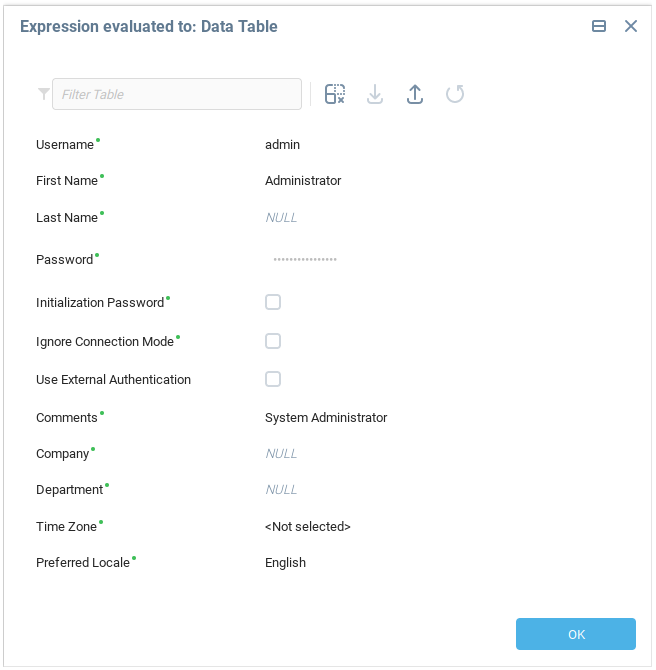
Now let's use one of the simplest possible queries to get the value of this variable from just one context.
Query Text:
SELECT
*
FROM
users.admin:childInfoResult of this query is a table showing the value of the childInfo variable defined in the users.admin context.
 | When viewing or editing the properties of some system object or hardware device, its context name is usually shown in the window header:  |
This query contains two clauses: SELECT and FROM. The SELECT clauses says that we should select all fields ("*"). The FROM clause contains a single Context Reference ("users.admin:childInfo") used to build a table on which the query will be executed. The contents and format of this table will match the value of the childInfo variable exactly.
All fields in the result of this query will be editable except for the fields that are defined as read-only in the format of childInfo variable.
 | When viewing or editing the properties of some context (such as the User context), you usually see variable descriptions rather than variable names. But we must use variable names in query text: Variable names are usually shown in the tooltips that appear when the mouse hovers over a variable description |
Query Result:

Selecting All Users' Info
Now let's select the properties of all users in the system:
Query Text:
SELECT
*
FROM
users.*:childInfoThe Context Reference (users.*:childInfo) contained in the text of this query is actually a mask of contexts. During query execution this mask will resolve to the list of all user contexts accessible by the user executing the query. See Context References chapter for more info.
This query results in a table with the values of the childInfo variable of every user account accessible by the user who is executing the query. It will probably contain multiple records, one per every user account. The result of this query will also be editable.
This query is built-in to the Iotellect Server distribution. It is called All Users.
Query Result:

For example, you can now change the first name and last name of some user and save the changes:

Changes will be immediately visible in other parts of the system:

Sorting User List
Now let's sort the table.
Query Text:
SELECT
*
FROM
users.*:childInfo order by childInfo$name descThis query outputs almost the same table as the previous one, but the rows in this table are sorted by Username (name field in the format of the childInfo variable) in descending order. The query contains a two-component Field Reference (childInfo$name), used to refer to a field within the table built when resolving the Context Reference users.*:childInfo.
 | When we examine value of "childInfo" variable in Iotellect Client or other Iotellect Server User Interface, field descriptions are shown in the table header instead of field names. But we must use field name in order to refer to it in query text. Field names are usually shown in tooltips that appear when mouse hovers over the field header: 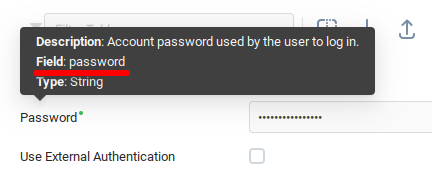 |
Using Table Aliases
We can edit the query and assign an alias, info, to our Context Reference, and then use a three-component Field Reference that includes this alias:
SELECT
*
FROM
users.*:childInfo as info
ORDER BY
info.childInfo$name descThe result of this query is exactly like the previous one.
Restricting Selected Fields
Now let's select just a limited number of fields by further modifying the same query.
Query Text:
SELECT
childInfo$name, childInfo$firstname, childInfo$lastname
FROM
users.*:childInfo
ORDER BY
childInfo$name descThis query contains a number of Field References in the SELECT clause. Since the fields are specified explicitly, the query result will be not editable, unless we add the write-back fields. We'll add them to this query in one of the next examples.
The result of this query will contain just three columns.
Query Result:
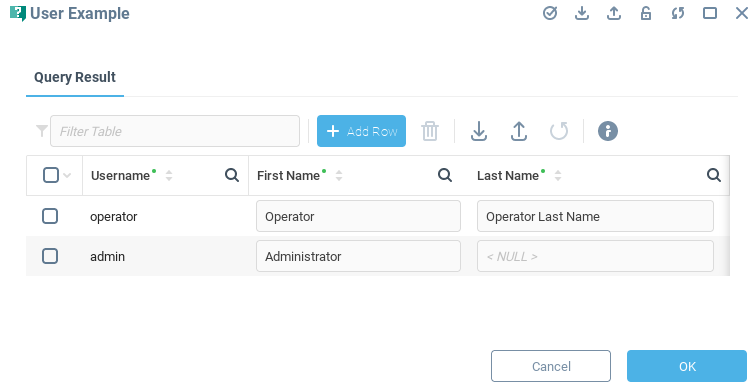
Adding Expressions
Let's now use a Query Language expression to show the first and last name of users in a single column, to make browsing more convenient. We'll also add a new column to the query result, user's country.
Query Text:
SELECT
childInfo$name,
CASEWHEN((childInfo$firstname IS NULL), '', childInfo$firstname) || ' ' || CASEWHEN((childInfo$lastname IS NULL), '', childInfo$lastname),
childInfo$country
FROM
users.*:childInfo
ORDER BY
childInfo$name descThis query selects three fields from the source table. The first and third fields contain the user's username and country respectively. The value of the second field is calculated using an expression. This expression gets a user's first name and appends a space and the user's last name to it. The double pipe marks (||) used are just a standard SQL operator, used for concatenating the strings. The first and last names are transformed using the CASEWHEN built-in function to make sure that an empty string is shown if value of the first or last name is NULL ("<Not set>"). Note that the name for the second column is generated automatically.
Query Result:
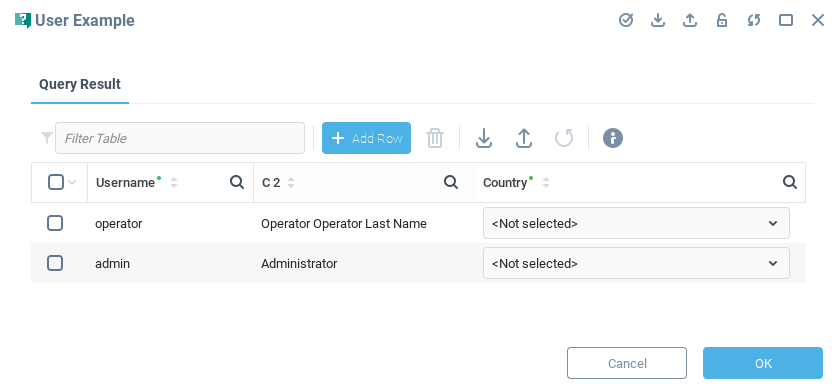
Using Field Aliases
Now let's assign a custom name ("label") to the second column to make the result more readable.
Query Text:
SELECT
childInfo$name,
CASEWHEN((childInfo$firstname IS NULL), '', childInfo$firstname) || ' ' || CASEWHEN((childInfo$lastname IS NULL), '', childInfo$lastname) as name,
childInfo$country
FROM
users.*:childInfo
ORDER BY
childInfo$name descSecond column is now called "name" in query result.
Query Result:
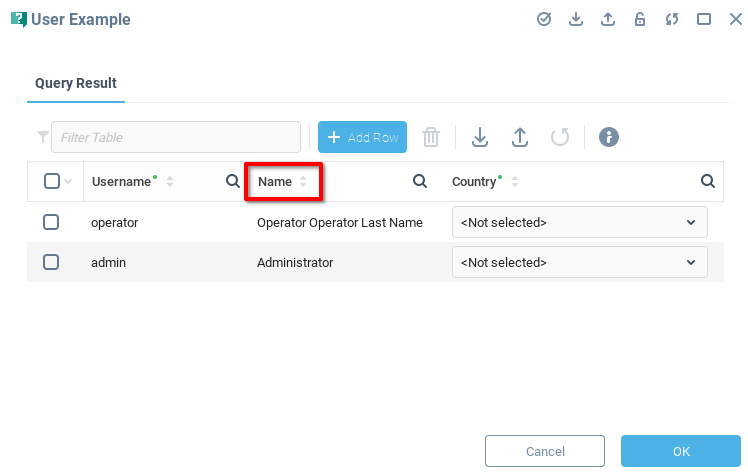
Enabling Editable Results
Now let's make it possible to change the users' countries -- add write-back fields to make the result editable. To add them we should assign an alias to the Context Reference ("table alias"), because write-back fields (CONTEXT_ID, PARENT_ID and RECORD_INDEX) have to be specified for a given context reference. To specify which reference should be written back, you have to use an alias. Carefully read the example below to figure it all out.
Query Text:
SELECT
info.childInfo$name,
CASEWHEN((info.childInfo$firstname IS NULL), '', info.childInfo$firstname) || ' ' || CASEWHEN((info.childInfo$lastname IS NULL), '', info.childInfo$lastname) as name,
info.childInfo$country,
info.CONTEXT_ID,
info.PARENT_ID,
info.RECORD_INDEX
FROM
users.*:childInfo as info
ORDER BY
info.childInfo$name descIn the result of this query, Country column will be editable. Username column is still read-only because it is read-only in the source variable ("childInfo"). Name column is read-only because it is calculated using an expression.
Note that additional users “test1”, “test2”, “test3”, and so on, have been added.
Query Result:
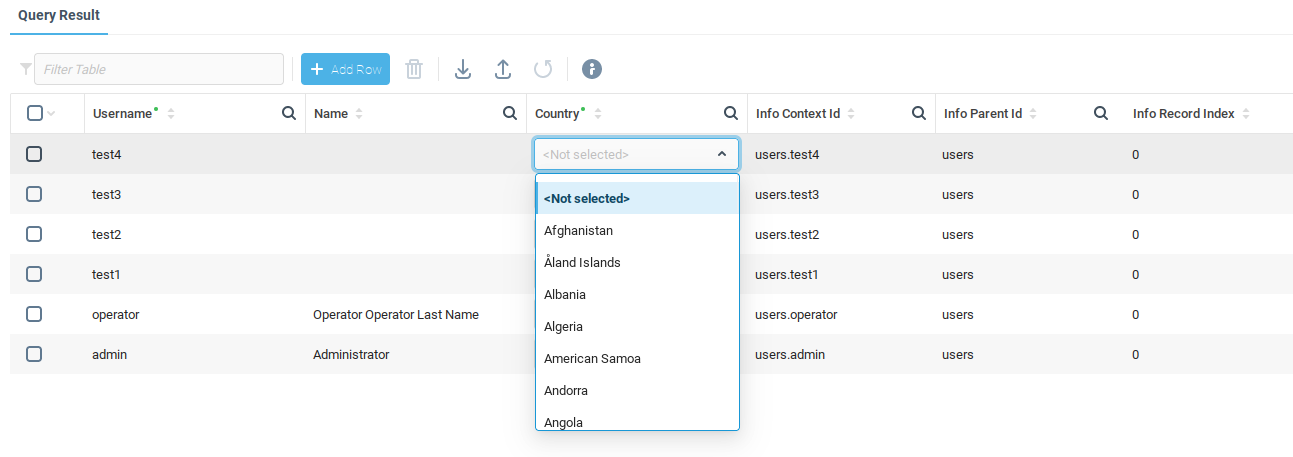
Filtering User List
Now let's add some filtering rules to the query. As an example, let's select only users whose usernames doesn't contain word "test".
Query Text:
SELECT
info.childInfo$name,
CASEWHEN((info.childInfo$firstname IS NULL), '', info.childInfo$firstname) || ' ' || CASEWHEN((info.childInfo$lastname IS NULL), '', info.childInfo$lastname) as name,
info.childInfo$country,
info.CONTEXT_ID,
info.PARENT_ID,
info.RECORD_INDEX
FROM
users.*:childInfo as info
WHERE
info.childInfo$name NOT LIKE '%test%'
ORDER BY
info.childInfo$name descThis query contains an additional WHERE clause, specifying which records should be included in the result.
Query Result:

Limiting the Output
The last line of the next example shows the LIMIT clause, used to restrict query result to a specified range of rows.
Query Text:
SELECT
info.childInfo$name,
CASEWHEN((info.childInfo$firstname IS NULL), '', info.childInfo$firstname) || ' ' || CASEWHEN((info.childInfo$lastname IS NULL), '', info.childInfo$lastname) as name,
info.childInfo$country,
info.CONTEXT_ID,
info.PARENT_ID,
info.RECORD_INDEX
FROM
users.*:childInfo as info
WHERE
info.childInfo$name NOT LIKE '%test%'
ORDER BY
info.childInfo$name desc
LIMIT 1 OFFSET 1Result of this query includes just one (LIMIT 1) record (the 2nd in the result of previous query). We use OFFSET 1 here. This means we're going to get 1 record (LIMIT 1) starting from the second record (OFFSET 1). The OFFSET clause tells Iotellect to start taking record from the second record onwards (the first record's offset is 0).
Query Result:

Example 2: Viewing/Editing Device Server Accounts
This example is similar to selecting the basic properties of all users as described in the previous example, but here we use the deviceServerInfo variable ("Device Server Information") defined in the Device Server context.
Query Text:
SELECT
*
FROM
users.*.deviceservers.*:deviceServerInfoThe text of this query includes a single Context Reference (users.*.deviceservers.*:deviceServerInfo) with a context mask that expands to all Device Server contexts which are accessible with the permissions of the user executing the query. The results of this query are editable, except for the fields that are read-only in the definition of the deviceServerInfo variable.
This query is built-in to the Iotellect Server distribution. It is called "All Device Servers".
Example 3: Viewing Device Server Traffic Statistics
This example shows the usage of Context References that include multiple variables/fields.
Query Text:
SELECT
info.deviceServerInfo$owner,
info.deviceServerInfo$name,
info.status$servertods,
info.status$dstoserver
FROM
users.*.deviceservers.*:status:deviceServerInfo as info
ORDER BY
info.deviceServerInfo$owner,
info.deviceServerInfo$nameContext Reference in this query ("users.*.deviceservers.*:status:deviceServerInfo") refers two variables defined in Device Server context: "deviceServerInfo" mentioned in previous example and "status" ("Device Server Status") that contains some real-time values related to Device Server functioning. The values of both variables contain just one record, so the table that will be built after resolving this context reference will contain all fields that appear in the values of both variables and one record per every Device Server accessible by the user executing query.
From this table we select four columns: two that appear in the value of deviceServerInfo (Owner and name of Device Server) and two from status (Incoming and outgoing traffic). The table is sorted by two fields: first by Device Server owner, then by Device Server name (because some Device Servers may have the same owner).
This query is built-in to the Iotellect Server distribution. It is called "Device Server Traffic Statistics".
Example 4: Buzzing Device Servers
This example shows how context functions may be used in the query.
Query Text:
SELECT
*
FROM
external_device_servers.*:buzz()This query is very interesting because it doesn't produce any output, but causes a side-effect on the server. It includes one Context Reference ("external_device_servers.*:buzz()") that involves the buzz() function ("Buzz Device Server") defined in the External Device Server context. This function is called without parameters, as specified by the empty parenthesis. The buzz function causes Device Server to blink its LEDs, helping to locate visually. Thus, this query helps to locate all Device Server that are visible by the Iotellect Server in the local network segment. It it very important to run the Discover Device Server action before executing this query. This action forces Iotellect Server to find all local Device Servers by sending broadcast network commands. See External Device Servers for more info.
If discovery was not performed, the External Device Servers context will not have any children, the external_device_servers.*context mask will not resolve to any context and no action will be performed on query execution.
The output of buzz() function contains no fields of records, so this query doesn't return any data. But its execution causes all External Device Server to buzz helping to locate them.
This query is built-in to the Iotellect Server distribution. It is called "Buzz All External Device Servers".
Example 5: Calculating Total Traffic of All Device Servers
This example shows how aggregation functions can be used.
Query Text:
SELECT
SUM(status$servertods) as server_to_ds,
SUM(status$dstoserver) as ds_to_server
FROM
users.*.deviceservers.*:statusIn one of the previous examples we've mentioned the status variable ("Device Server Status") that is defined in the Device Server context and contains statistics of traffic between Iotellect Server and the Device Server. This query calculates how many bytes were sent to all currently visible Device Server and how many bytes were received from them. The query result contain one record, because the SUM aggregation function is used.
 | Since the query result contains just one row, it is shown using a "vertical" two-column layout, where field names are shown in the first column and field values in the second. |
 | This example could be easily modified to use other aggregation functions:
|
Example 6: Executing Query on Multiple Tables
This example shows how to execute queries on multiple tables (built from multiple Context References).
Query Text:
SELECT
d.deviceServerInfo$owner || '.' || d.deviceServerInfo$name as device_server,
d.deviceServerInfo$blocked,
u.childInfo$city,
u.childInfo$country
FROM
users.*:childInfo as u, users.*.deviceservers.*:deviceServerInfo as d
WHERE
u.childInfo$name = d.deviceServerInfo$ownerThis query has two Context References in the FROM clause. The first one is used to build a table containing all basic settings of all users, and the second one results in a table of all basic settings of all Device Server. These tables are then joined together based on the formula contained in WHERE clause ("u.childInfo$name = d.deviceServerInfo$owner"). The query result has four fields: first contains full Device Server name in the form "Owner Name"."Device Server Name". Second shows "Blocked" status of the Device Server. Two other columns show city and country of the user who owns the Device Server (which are probably the city and country where Device Server is located).
Example 7: Using JOINs
This example shows how to use SQL JOIN and hidden fields to combine data from two tables generated from two different context references.
When Iotellect is used for network management, Iotellect Server operates with devices using SNMP protocol. Every SNMP device has a so-called Interface Table (ifTable variable of device context) containing statistics of device's network interfaces. The below query finds all network interface of all SNMP devices those status is down (i.e. ifOperStatus field equals to 2).
The query joins description of device context (i.e. device name) to the description of network interface to show them in one table.
SELECT
info.info$description, ift.ifTable$ifDescr, ift.ifTable$ifOperStatus
FROM
users.*.devices.*:ifTable as ift LEFT OUTER JOIN users.*.devices.*:info as info ON ift$CONTEXT_ID = info$CONTEXT_ID
WHERE
ift.ifTable$ifOperStatus = 2More Real World Examples
Getting Login Events Of a User
This query calls get() function from events context and filters resulting table by username.
SELECT
*
FROM
events:get("users", "login") as logins
WHERE
logins.get$username = 'operator'Note, that same results may be obtained by passing filter expression into the get() function call:
SELECT
*
FROM
events:get("users", "login", "{username} == 'operator'") as loginsFinding Network Devices With High Response Time
This query finds all network devices those response time is over 500 ms and shows their names along with current response time.
SELECT
info.info$description AS device,
ping.ping$averageTime AS average_round_trip_time
FROM
users.*.devices.*:info AS info
RIGHT OUTER JOIN
users.*.devices.*:ping AS ping
ON
ping$CONTEXT_ID = info$CONTEXT_ID
WHERE
ping.ping$averageTime > 500
ORDER BY
ping.ping$averageTime DESCFinding Network Device With High CPU Load
This query finds all network (SNMP-enabled) devices that have an average load of all their processors higher than 90%. It works perfectly for multi-processor devices.
SELECT
info.info$description AS device,
avg(processors.hrProcessorTable$hrProcessorLoad) AS processor_utilization_percentage
FROM
users.*.devices.*:hrProcessorTable AS processors
LEFT OUTER JOIN
users.*.devices.*:info as info
ON
processors$CONTEXT_ID = info$CONTEXT_ID
GROUP BY
device
HAVING
avg(processors.hrProcessorTable$hrProcessorLoad) > 90
ORDER BY
processor_utilization_percentage DESCGrouping SNMP Devices By Type
This query calculates number of SNMP devices of every type (type is specified by sysObjectID variable provided by device itself) and shows summary table. Note, that descriptions of every device type are taken from common table called deviceTypes.
SELECT
coalesce(types.value$description, snmp.sysObjectID$sysObjectID) AS device_type,
COUNT(*) AS device_count
FROM
users.*.devices.*:status:sysObjectID AS snmp
LEFT JOIN
common.deviceTypes:value AS types
ON
snmp.sysObjectID$sysObjectID = types.value$type
WHERE
snmp.status$driver = 'com.tibbo.linkserver.plugin.device.snmp'
GROUP BY
device_type
ORDER BY
device_count DESCGetting Device Setting Statistics
This query uses statistics function defined in Utilities context to extract last values of a statistical channel. The channel is configured to count network device's interface errors that occurred every hour/day/month.
The query groups all device's interface tables into one and use it as a base (FROM users.*.devices.*:ifTable AS interfaces). Then it LEFT OUTER JOIN's last hour's data from two statistical channels named "ifInOctets" and "ifOutOctets" (LEFT OUTER JOIN utilities:statistics("users.*.devices.*", "ifInErrors", null, "hour") AS in_errors). And finally it LEFT OUTER JOIN's generic device information (LEFT OUTER JOIN users.*.devices.*:info AS info). The query also features filtering, sorting and results row limit.
SELECT
info.info$description AS device,
interfaces.ifTable$ifDescr AS interface,
in_errors.statistics$average * 3600 AS incoming_errors,
out_errors.statistics$average * 3600 AS outgoing_errors
FROM
users.*.devices.*:ifTable AS interfaces
LEFT OUTER JOIN
utilities:statistics("users.*.devices.*", "ifInErrors", null, "hour") AS in_errors
ON
interfaces.ifTable$ifIndex = in_errors.statistics$key
AND
interfaces$CONTEXT_ID = in_errors.statistics$context
LEFT OUTER JOIN
utilities:statistics("users.*.devices.*", "ifOutErrors", null, "hour") AS out_errors
ON
interfaces.ifTable$ifIndex = out_errors.statistics$key
AND
interfaces$CONTEXT_ID = out_errors.statistics$context
LEFT OUTER JOIN
users.*.devices.*:info AS info
ON
info$CONTEXT_ID = interfaces$CONTEXT_ID
WHERE
length(interfaces.ifTable$ifDescr) > 1
ORDER BY
incoming_errors + outgoing_errors DESC
LIMIT
10Listing Cardholders by Divisions
In the Iotellect Time and Attendance, the system processes attendance data for cardholders forming a complex hierarchy that includes organizations, divisions, and possibly departments. Since context path of every cardholder starts with context path of the division he belongs to, we can build a query that lists cardholders by divisions:
SELECT
divisions.childInfo$name,
cardholders.childInfo$name
FROM
organizations.Organization1.divisions.*.cardholders.*:childInfo as cardholders,
organizations.Organization1.divisions.*:childInfo as divisions
WHERE
substring(cardholders.CONTEXT_ID, 1, length(divisions.CONTEXT_ID)) = divisions.CONTEXT_IDGetting Alerts Active for Multiple Devices
In the below example, each device has custom_childContext tabular custom property that lists all devices dependent on it. This property has contextPath field that contains paths of dependent devices.
The query checks triggers listed in activeInstances tables of all alerts. Only triggers those source field equals to context path of selected device (i.CONTEXT_ID) or listed in custom_childContext table of selected device will be selected.
Thus, the query will return alert triggers that are active either for current device (dev1) or for its dependent devices.
SELECT
*
FROM
users.*.alerts.*:activeInstances AS at
WHERE
at.activeInstances$source IN
(
SELECT
i.CONTEXT_ID
FROM users.admin.devices.dev1:info AS i
UNION SELECT
c.custom_childContexts$contextPath
FROM users.admin.devices.dev1:custom_childContexts AS c
)Joining Historical Values of Multiple Variables
The variableHistory function can load historical values of any context variable. This is suitable to show those values in a report, on a dashboard, etc. But what if you want to show values of multiple variables in a single table? For example, you're measuring temperature and history, and want the measurements to be presented as a single table. Here is a solution.
The below query loads 10-days history of two separate variables in two virtual tables and JOINs those tables by putting together values those timestamps are equal with one second precision.
SELECT
sineTimeString, sineTime, sineValue, triangleTime, triangleValue
FROM
(
SELECT
TO_CHAR(sine.variableHistory$vUpdateTime, 'DD.MM.YYYY H:MI:SS') as sineTimeString, sine.variableHistory$vUpdateTime as sineTime, sine.variableHistory$value as sineValue
FROM
utilities:variableHistory("users.admin.devices.demoVirtualDevice", "sine", 'dateAdd(now(), -10, "m")') as sine
)
JOIN
(
SELECT
TO_CHAR(triangle.variableHistory$vUpdateTime, 'DD.MM.YYYY H:MI:SS') as triangleTimeString, triangle.variableHistory$vUpdateTime as triangleTime, triangle.variableHistory$value as triangleValue
FROM
utilities:variableHistory("users.admin.devices.demoVirtualDevice", "triangle", 'dateAdd(now(), -10, "m")') as triangle
)
ON
sineTimeString = triangleTimeStringUnifying Results of Several Sub-Queries
The below query refers three other queries by listing their data variables in the FROM clauses of primary and nested SELECT statements. The three query result sets are glued together using UNION operators.
SELECT
hpux.data$icon AS icon,
hpux.data$device AS device,
hpux.data$context AS context,
hpux.data$cpu AS cpu,
hpux.data$max_threshold as max_threshold,
hpux.data$min_threshold as min_threshold,
hpux.data$max_threshold - hpux.data$cpu as margin,
CASEWHEN(hpux.data$max_threshold - hpux.data$cpu < 0,
2,
CASEWHEN(hpux.data$max_threshold - hpux.data$cpu < 10, 1, 0) ) as condition
FROM
users.admin.queries.cpu_HPUX:data as hpux
UNION ALL
(SELECT
standard.data$icon AS icon,
standard.data$device AS device,
standard.data$context AS context,
standard.data$cpu AS cpu,
standard.data$max_threshold as max_threshold,
standard.data$min_threshold as min_threshold,
standard.data$max_threshold - standard.data$cpu as margin,
CASEWHEN(standard.data$max_threshold - standard.data$cpu < 0,
2,
CASEWHEN(standard.data$max_threshold - standard.data$cpu < 10, 1, 0) ) as condition
FROM
users.admin.queries.cpu_standard:data as standard
UNION ALL
(SELECT
sun.data$icon AS icon,
sun.data$device AS device,
sun.data$context AS context,
sun.data$cpu AS cpu,
sun.data$max_threshold as max_threshold,
sun.data$min_threshold as min_threshold,
sun.data$max_threshold - sun.data$cpu as margin,
CASEWHEN(sun.data$max_threshold - sun.data$cpu < 0,
2,
CASEWHEN(sun.data$max_threshold - sun.data$cpu < 10, 1, 0) ) as condition
FROM
users.admin.queries.cpu_Sun:data as sun))
ORDER BY
marginExecuting Expressions from Queries
This example illustrates how to evaluate Iotellect expressions from queries. The query lists device setting variables (technically, variables that belong to remote group and its subgroups) of a device along with their values. Values are retrieved by calling EVALUATE_TO_STRING function that performs a call to getVariable() expression language function and encodes obtained tables into strings using encode() function. The getVariable() call refers to default context (pointed by dc() function), so this default context is passed to EVALUATE_TO_STRING function by using variables$CONTEXT_ID field reference.
Since the query will return variable values as strings, it's necessary to use query's Output Format parameter to specify that value column should be converted to Data Table type.
SELECT
variables.variables$name as name,
EVALUATE_TO_STRING('encode(getVariable(dc(), "'+variables.variables$name+'"))', variables$CONTEXT_ID, null) as value
FROM
users.admin.devices.device1:variables as variables
WHERE
SUBSTRING(variables.variables$group, 1, 7) = 'remote|'Was this page helpful?